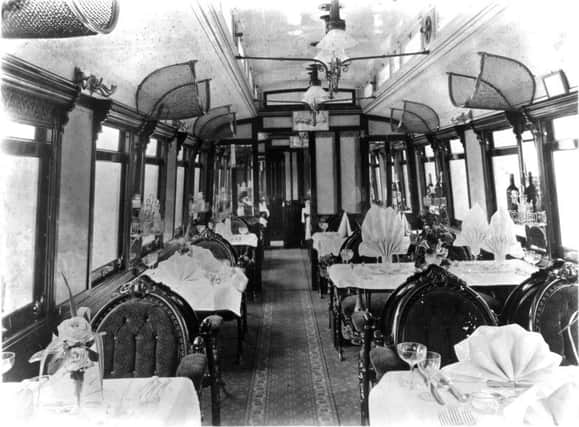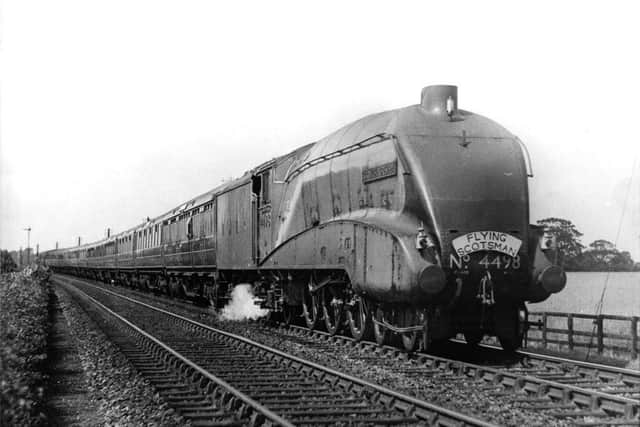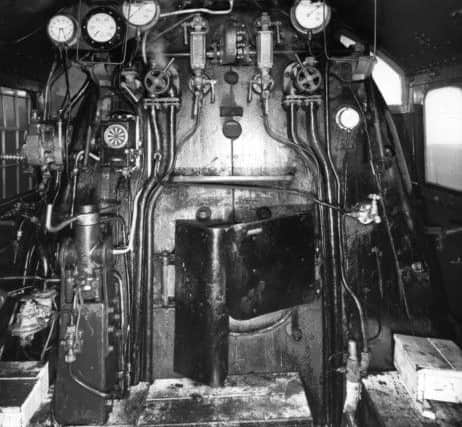Why The Flying Scotsman holds such a special place in Yorkshire's heart


The first Flying Scotsman trains left simultaneously from the Great Northern Railway’s King’s Cross and the North British Railway’s Edinburgh Waverley in June 1862 and took 101/2 hours to reach their destination. By 1872 the journey time was cut to 91/2 hours and four years later to 9 hours. Seating was only available for first and second class passengers. During this early period there was no dining car and so the journey allowed half an hour for passengers to grab a hurried meal in York station’s dining room.
Flying Scotsman’s route did not follow the one we know today. The line running north, after reaching Doncaster, travelled over the Lancashire & Yorkshire Railway to Knottingley and round on to the old Normanton and York line at Burton Salmon. This continued until January 1871, when a route from Shaftholme junction four and a half miles north of Doncaster was opened by the then North Eastern Railway through Selby to York. Also the route through York and onwards to Newcastle was different. Trains arriving at York ran into a terminal station, so that reversal from there was necessary. Alternative routes from Ferryhill to Newcastle were not implemented until 1872. At Newcastle reversal was also necessary until the bridge over the Tyne was opened in 1906.
Advertisement
Hide AdAdvertisement
Hide AdDuring November 1887 admission was granted for the first time on the train for third-class passengers. A year later came the announcement that the Flying Scotsman would take eight and a half hours, which led to the two historic ‘Races to the North’. This was the name given by the press to events in the summers of 1888 and 1889 when passenger trains belonging to the east and west coast railway companies would race each other from London to Scotland. The ‘Races’ were never official and publicly the companies involved strenuously denied there was any racing at all. During the racing period the journey time of the Flying Scotsman was cut to seven hours 26 and three qaurter minutes, but settled down once again to eight and a half hours.


Carriages used for Flying Scotsman and other East Coast services were named East Coast Joint Stock. The cost of building and maintaining them was jointly provided by the Great Northern Railway, North Eastern Railway and North British Railway over whose territory the rails extended. A large proportion of the carriages used were built at Doncaster and by private contractors. In 1900, Doncaster built, three composite first/third dining saloons with central kitchens as well as three first class dining cars with their own kitchens. Some of these were used for the first time with Flying Scotsman service.
During the late 19th century and early 20th century Flying Scotsman trains were hauled by the Stirling Singles and Ivatt Atlantic locomotives. Then, in the early 1920s, the LNER’s chief mechanical engineer Nigel Gresley designed an express passenger engine – the A1 – with greater power than ever before. The first of this type to be built for the LNER, on February 24, 1923 was no. 1472, later named Flying Scotsman.
The engine had a taste of the publicity it was to enjoy in later years when selected to appear at the British Empire Exhibition in London in 1924. The next major breakthrough for Flying Scotsman train services came on May 1, 1928 when, for the first time, it was scheduled to run non-stop between the two capitals. To announce details of the service the LNER took advertising space in most national daily newspapers. Perhaps an obvious choice to haul the train north out of King’s Cross at 10 am was the appropriately named Flying Scotsman locomotive.
Advertisement
Hide AdAdvertisement
Hide AdJust after 6 pm locomotive and train eased into Edinburgh Waverley railway station amidst loud cheers from hundreds of people . It had successfully completed the 392 miles between London and Edinburgh without stopping, a record at the time for the LNER. The 1928 non-stop Flying Scotsman had improved catering and other on-board services –- even a barber’s shop.


On the same day, the non-stop Flying Scotsman train from Edinburgh to London, which had left the Scottish capital was greeted with the same applause at King’s Cross.
Both train services used two sets of locomotive crew. For the first north-bound run, the engine was crewed by driver Pibworth and fireman Goddard on the southern section, with Messrs Blades and Morris of Gateshead taking over north of York. Inspector Brammall was assigned to accompany the crews. The relief crews accessed the locomotives from a carriage via the new type of corridor tender. Nigel Gresley himself rode part of the way on the King’s Cross to Edinburgh train. In order not to run out of water, the locomotives picked up gallons of it by means of a scoop from troughs positioned between the running rails on the track.
More publicity was gained for Flying Scotsman locomotive in 1934 when it was clocked 100mph on a test run. Officially this was the first UK locomotive to have reached that speed. Since 1928, the Flying Scotsman train has been hauled by various classes of steam, diesel-electric and electric locomotives and continues today. Withdrawn from BR service in 1963 but preserved, the locomotive made an historic run on the Flying Scotsman service in 1968 - 100 years after the first service began.
Advertisement
Hide AdAdvertisement
Hide AdThousands of people tuned out a short time ago to see the engine reappear after a very expensive overhaul. This went a long way to prove that the Flying Scotsman name is as popular today as in any period of its long eventful history.